Meaning of Charles I in Three Positions Painting
A Masterpiece of Royal Representation and Symbolic Power
In the grand lineage of regal portraiture, few works capture the mystique, tragedy, and complex political symbolism of monarchy as profoundly as “Charles I in Three Positions” by Sir Anthony van Dyck. Painted in 1635–1636, this remarkable triple portrait is more than a study in aesthetics or physiognomy, it is a window into the troubled reign of a king, a reflection of Baroque artistic mastery, and a piece imbued with the layered iconography of royal power, divine right, and impending downfall.
This story explores the historical, symbolic, and artistic significance of this famous work, unraveling the many layers behind its creation, composition, and legacy.
Who Was Anthony van Dyck?
Before delving into the painting itself, it’s crucial to understand the artist behind the canvas. Sir Anthony van Dyck (1599–1641) was a Flemish Baroque painter, celebrated for his court portraits, particularly those depicting English aristocracy. A prodigy trained under Peter Paul Rubens, van Dyck possessed a unique ability to fuse realism with elegance, rendering his subjects with both grandeur and psychological depth.
Van Dyck became Principal Painter in Ordinary to King Charles I in 1632. He was knighted and given a residence, and his artistic vision came to define the royal image of Charles I, portraying him as graceful, serene, and dignified, a contrast to the political unrest brewing around him.
The Creation of “Charles I in Three Positions”
“Charles I in Three Positions” (also known as The Triple Portrait of Charles I) was painted around 1635–36, during van Dyck’s tenure at the English court. The commission, however, was not simply a conventional portrait for English display.
This unusual composition was created to assist Gian Lorenzo Bernini, the great Italian sculptor and architect, in crafting a marble bust of Charles I. Bernini had never seen the king in person and required detailed visual references. To meet this need, van Dyck painted Charles I from three different angles, left profile, full face, and right three-quarter view, on a single canvas.
The finished painting was sent to Rome, where Bernini used it to sculpt the bust, which was completed in 1638. The bust was well-received and admired, especially by Queen Henrietta Maria. Tragically, the bust was destroyed in a fire at Whitehall Palace in 1698, making van Dyck’s painting even more significant as the surviving record of that artistic collaboration.
What Is Depicted in the Painting?
The painting itself shows three distinct views of Charles I, all dressed similarly in a blue and silver brocade doublet with lace collars, and each wearing a variation of the Order of the Garter, a symbol of the English monarchy’s chivalric traditions.
The left-facing view shows Charles in left profile, his hair slightly curled, his expression reserved, introspective.
The central portrait presents a frontal, full-face view, where Charles gazes calmly and directly at the viewer. This is the most regal and balanced of the three.
The right-facing view is a three-quarter profile, slightly turned toward the center. It is perhaps the most dynamic of the trio, with a livelier eye and posture.
While all three versions clearly represent the same individual, van Dyck subtly differentiates them, not just in terms of angles, but in emotional timbre and psychological suggestion. Each view captures a different mood or quality of Charles: solemnity, sovereignty, and contemplative authority.
What Type of Art Is It?
“Charles I in Three Positions” is a Baroque portrait, combining the drama and elegance typical of the period. While Baroque art is often associated with theatricality, van Dyck’s approach is more restrained, favoring grace and dignity over overt drama.
More specifically, the painting is a triple portrait, a genre relatively rare in Western art. Its format was primarily practical, used for sculptural reference, rather than meant for public display. Yet it transcends that function through van Dyck’s meticulous execution and conceptual depth, becoming a symbolic icon of monarchy and identity.
Symbolism and Deeper Meaning
At first glance, the portrait seems purely functional, a pragmatic solution to aid Bernini. But viewed through the lens of historical context and artistic intent, its deeper meanings become apparent.
1. The Holy Trinity Motif
Some scholars interpret the triple view as an allusion to the Holy Trinity, Father, Son, and Holy Spirit. In this framework, Charles I is aligned with divine authority, reinforcing his belief in the divine right of kings. The Trinity symbolism also elevates Charles beyond the mortal realm, portraying him almost as a sanctified figure, chosen and immutable.
2. The Multiplicity of Monarchy
By presenting three faces, van Dyck underscores the multiple roles of a king: the ruler, the individual, the symbol of the state. These are not merely different angles, but representations of Charles I as public persona, private man, and divine monarch. It echoes the idea that monarchy is not a singular identity, but a composite of responsibilities and perceptions.
3. Psychological Duality
There is a palpable tension in the painting. The central face appears calm and authoritative, but the side profiles suggest vulnerability, particularly the left, which appears more withdrawn. This subtle psychological interplay may hint at Charles’s own internal conflicts and growing unease with the political tides turning against him.
4. The Use of Color and Clothing
Charles’s attire is symbolic in itself. The rich blue of the Order of the Garter sash evokes loyalty, nobility, and the enduring traditions of monarchy. The lace collars suggest refinement and courtly elegance, distancing the king from the common world and situating him in the aristocratic ideal.
What Was Happening at the Time?
When van Dyck painted this portrait, Charles I was already embroiled in a fraught political landscape. His personal rule (1629–1640), in which he dissolved Parliament and governed alone, had created mounting resentment. His perceived Catholic sympathies, unpopular fiscal policies, and belief in divine monarchy clashed with growing demands for constitutional governance.
Though the painting exudes calm authority, it was created during an era of escalating crisis. Just a few years later, England would descend into Civil War (1642–1651). Charles I would be captured, tried, and executed in 1649, the first and only English monarch to be beheaded.
This tragic fate casts a retrospective shadow over the painting. It becomes not just a celebration of monarchy, but a memorial of a lost world. The triple portrait, with its composed dignity, becomes a kind of visual elegy, capturing a fleeting moment before the collapse.
Where Is the Painting Today?
The painting is currently housed in the Royal Collection at Windsor Castle, and remains one of the most important works of art in the British royal collection. Its value is not just artistic, but deeply historical and symbolic, offering a lens into one of the most pivotal periods in British history.
The fact that it survived the upheaval of the English Civil War, the execution of the king, and the temporary abolition of the monarchy, is remarkable. It stands today not only as an exquisite artwork, but as a survivor of history’s tempest.
Cultural Impact
“Charles I in Three Positions” has had a lasting influence in both art and culture:
It set a precedent for the use of multi-angle portraits in sculpture and other mediums.
The image of Charles I, particularly as painted by van Dyck, became central to Royalist propaganda and nostalgia during and after the Civil War.
It influenced representations of monarchy in subsequent centuries, reinforcing the ideal of a king as both divine and mortal.
In modern culture, the triple view format has inspired homages in photography, film, and fashion, where it often symbolizes multiplicity of identity.
Perhaps most profoundly, the painting endures as a powerful metaphor: of kingship under siege, of the tension between power and fragility, and of the attempt to preserve permanence in the face of history’s inevitable change.
The Enduring Mystery and Majesty of Charles I in Three Positions
Anthony van Dyck’s “Charles I in Three Positions” is more than a technical marvel or a portrait commission, it is an iconic artifact of a vanished age. Through its elegant composition and symbolic depth, it captures the complex identity of Charles I at a moment of personal and national crisis.
It invites us to reflect not only on the power of art, but on the fragility of power itself. Though Charles sought to rule with absolute authority, his image, captured by van Dyck, endures in a form that is more intimate and more eternal than politics could ever provide.
The painting reminds us that while thrones may fall, art preserves a different kind of sovereignty, one of memory, emotion, and eternal gaze. In the three faces of Charles I, we do not merely see a king; we see the ghost of monarchy, the soul of a nation in conflict, and the profound capability of art to speak across centuries.




